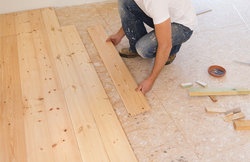 Behind the world’s greatest inventions there’s always a great inventor. Behind the fastest race car, is the best performing engine. Behind the best tasting beer, is a really great recipe to make it. And here’s one you may or may not agree with: behind every great man, is an even greater woman. Ok, that one has likely stirred more than a few pots over the years, but the point is, behind just about everything great, there’s usually something else that made it so great. That’s true for every floor installation. Behind every great install, is a really great subfloor. The customer never sees it, but it’s the real reason the floor looks and sounds (or doesn’t sound) the way it does.
Behind the world’s greatest inventions there’s always a great inventor. Behind the fastest race car, is the best performing engine. Behind the best tasting beer, is a really great recipe to make it. And here’s one you may or may not agree with: behind every great man, is an even greater woman. Ok, that one has likely stirred more than a few pots over the years, but the point is, behind just about everything great, there’s usually something else that made it so great. That’s true for every floor installation. Behind every great install, is a really great subfloor. The customer never sees it, but it’s the real reason the floor looks and sounds (or doesn’t sound) the way it does.
There’s not a contractor out there that wants to hear back from clients a year after their flooring installation…unless they’re calling them back to work on a new project. Client callbacks are one of the leading causes of frustration from contractors and let’s face it, the customer making the call is pretty frustrated too. Callbacks for squeaky floors literally take money out of the contractor’s pocket.
Over the years we’ve been asked several great questions about how to avoid those callbacks by properly installing subfloors the right way the first time. Here are the 5 most popular questions and their respective answers:
- How important is proper sheathing?
Sheathing is extremely important to avoid squeaking from the subfloor. It’s critical to ensure that the subfloor sheathing used is adequately fastened. Noise from the subfloor is most often caused by the subfloor sheathing rubbing against each other. To prevent this, make sure that you're using a high quality fastener that has been driven in far enough to create a snug hold.
When it comes to quality fasteners, we recommend SubLoc® PRO SCRAIL®, a performance-driving crossover between a nail and a screw featuring an adhesive coating and fine threads along the shank to dramatically improve holding power when compared to ring shank nails. - What kind of wood is recommended for a quality subfloor?
Kiln dried wood is the first choice here. It has the ability to expand and contract with changes in temperature and humidity levels. Make sure the wood is completely dried before installation. Any moisture in the wood will leave wiggle room between the joist and the subfloor when the wood dries creating squeaks and groans that lead to callbacks.
BECK's SubLoc® PRO SCRAIL® fasteners work very well to prevent this from happening in subfloors. They provide you with the tight hold of a screw, one that will resist loosening no matter how much the wood expands, because they're threaded just like a screw. - Which fastener is better for subfloors, nails or screws?
The debate has been raging for years as to which is better for constructing high quality subflooring -nails, or screws. While screws offer a longer lasting hold, they're more time consuming to use. Nails are more likely to loosen over time, especially when driven into wood which expands and contracts with the seasons, but the use of a pneumatic nail gun makes it quick and easy to drive them all the way into even the hardest of substrates.
Recent innovations by the BECK Fastener Group® have given those in the construction trade another fastener option, one that offers the hold of a screw with the ease of use of a nail. It's called SubLoc® PRO SCRAIL®, and its use can help you to save time, energy, and money while creating a subfloor that won't squeak. - What is the best way to attach the wood subfloor?
The best way to attach the panels is to join two corners and check the positioning and fit before completely securing the panel. Use a tapping block to achieve a tight and even seam between panels, and always stagger the seams to increase the strength and stability of the floor. Along the ends and edges of the sub-floor panels, it is recommended you apply nails or screws at 6-inch intervals. Along the joints, 10-inch spacing is recommended. You may also first apply a bead of construction-grade adhesive along the top of each joist. - If I do get a call to repair a squeaky floor what can I do?
It is possible to silence this annoyance by solidifying the connections, eliminating the movement causing the noise. This can be done in a number of ways:
o adding glued shims to fill any gaps (although this can backfire if the shim is too thick, making the problem worse)
o using adhesive construction glue (for minor voids)
o adding additional nails to the underside of the floor (although these can also eventually loosen)
o sister an adhesive-coated 2" x 4" or 2" x 6" to the loose joists or floorboards, tightening them with screws to establish a new, more solid connection.
For more information about installing squeakless subfloors, download the eGuide here:
The eGuide will give you great advice for installing the perfectly quite subfloor. What it won’t do, is answer the debate about whether there’s a great woman behind every great man. That one you will have to decide for yourself.
.svg.png)
